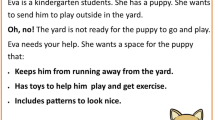Abstract
Preschool environments offer an abundance of opportunities for exploring the physical world where children can learn engineering concepts and principles (theories or laws). Yet how teachers design motivating conditions for engineering thinking has not been fully investigated. The study reported in this paper examined how teachers and young children engaged in engineering principles over 12 months. Digital video observations (123 h) captured the daily interactions of two teachers and 13 children across two classrooms during their engineering sessions. The participants were 8 preschool children aged 4.7–5.5 years and 5 school children aged 5.5–6.4 years. Different to previous studies that focus on engineering affordances during free play, the results identify new play pedagogies that support personally meaningful engineering learning of children in preschools. The new practices, named as an Engineering PlayWorld, build imaginary situations, where children in teams act ‘as if’ they are engineers, meeting engineering problems and generating engineering solutions.


Similar content being viewed by others
Data Availability
Not applicable.
References
Australian Academy of Science. (2019). Women in STEM Decadal Plan (Australian Academy of Science).
Bagiati, A., & Evangelou, D. (2016). Practicing engineering while building with blocks: identifying engineering thinking. European Early Childhood Education Research Journal, 24(1), 67–85. https://doi.org/10.1080/1350293X.2015.1120521.
Bagiati, A., Yoon, S. Y., Evangelou, D., & Ngambeki, I. (2019). Engineering curriculum in early education: describing the landscape of open resources. Accessed ecrp.uiuc.edu/v12n2/bogiati. 12(2), 1-15. Accessed 20 Oct 2020.
Bairaktarova, D. D., Evangelou, A., Bagiati, A., & Brophy, S. (2011). Engineering in young children’s exploratory play with tangible materials. Children, Youth and Environments, 21(2), 212–235.
Capobianco, B. B., Diefes-Dux, H. A., Mena, I., & Weller, J. (2011). What is an engineer? Implications of elementary school student conceptions for engineering education. Journal of Engineering Education, 100(2), 304–328.
Engineering Success in STEM. (2019). Promoting a culture inclusion in science and engineering. http://successinstem.ca. Accessed 20 Oct 2020.
Gold, Z. S., Elicker, J., Choi, J. Y., Anderson, T., & Brophy, S. P. (2015). Preschoolers’ engineering play behaviors: differences in gender and play context. Children, Youth and Environments, 25(3), 1–21.
Hedegaard, M. (2002). Learning and child development. A cultural-historical study. Aarhus: Aarhus University Press.
Hedegaard, M. (2008). The educational experiment. In M. Hedegaard & M. Fleer (Eds.), Studying children: a cultural historical perspective (pp. 181–201). New York: Open University Press.
Kaspura, A. (2017). The engineering profession: a statistical overview (Thirteenth ed.). Barton ACT: Institution of Engineers Australia.
Lippard, C. N., Lamm, M. H., & Riley, K. L. (2017). Engineering thinking in prekindergarten children: a systematic literature review. Journal of Engineering Education, 106(3), 454–474.
Lippard, C. N., Lamm, M. H., Tank, K. M., & Choi, J. Y. (2018). Pre-engineering thinking and the engineering habits of mind in preschool classroom. Early Childhood Education Journal, 47, 187–198. https://doi.org/10.1007/s10643-018-0898-6.
Lucas, B., Hanson, J., Bianchi, L., & Chippindall, J. (2017). Learning to be an engineer: implications for schools. London: Royal Academy of Engineers Retrieved from http://www.raeng.org.uk/policy/education-policy/learning-and-teaching. Accessed 20 Oct 2020.
Moore, T., Tank, K., & English, L. (2018). Engineering in the early grades: harnessing children’s natural ways of thinking. In L. English & T. Moore (Eds.), Early engineering learning (pp. 9–18). Singapore: Springer.
National Academy of Engineering & National Research Council. (2009). Engineering in K-12 education: understanding the status and improving the prospects. Washington, DC: The National Academies Press. Accessed. https://doi.org/10.17226/12635.
The Australian Industry Group. (2017). Strengthening school—industry stem skills partnerships. Final project report, Australia.
Vygotsky, L. S. (1987). Thinking and speech (N. Minick, Trans.). In R. W. Rieber & A. S. Carton (Eds.), The collected works of L. S. Vygotsky (Vol. 1). New York: Plenum Original work published 1934.
Vygotsky, L. S. (1993). The collected works of L.S. Vygotsky, “The fundamentals of defectology.” (Vol 2), (J. E. Knox and C. B. Stevens, Trans), R.W. Rieber and A.S Carton (Ed. English translation). New York: Kluwer Academic and Plenum Publishers.
Acknowledgements
Research assistance for data collection in this paper was provided by Sue March (field leader), Fatema Taj Johora, and Junqian Ma and data organisation by Freya Fleer-Stout and Ainslie Holland. Special acknowledgement is made of the two teachers who participated in the study, Rebecca and Oriana. Special thanks are given to the anonymous reviewers who supported the development of this paper.
Funding
Australian Research Council Discovery (ARC) Grant DP140101131 funded the study. Funds from the ARC FL180100161 also supported the refinement of the paper.
Author information
Authors and Affiliations
Corresponding author
Ethics declarations
Conflict of Interest
The author declares that there is no conflict of interest.
Code Availability
Not applicable.
Additional information
Publisher’s Note
Springer Nature remains neutral with regard to jurisdictional claims in published maps and institutional affiliations.
Rights and permissions
About this article
Cite this article
Fleer, M. Engineering PlayWorld—a Model of Practice to Support Children to Collectively Design, Imagine and Think Using Engineering Concepts. Res Sci Educ 52, 583–598 (2022). https://doi.org/10.1007/s11165-020-09970-6
Accepted:
Published:
Issue Date:
DOI: https://doi.org/10.1007/s11165-020-09970-6




